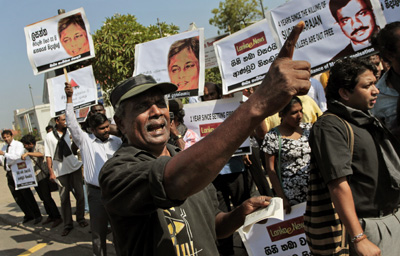On Monday, I wrote about two demonstrations scheduled for Sri Lanka this week. Both were meant to commemorate the ugly string of anti-press attacks in recent Januaries, which has included journalists killed and abducted, television stations bombed, websites attacked, and media offices torched. But Wednesday’s Black January effort, publicized by the Free Media Movement (FMM) and other media support groups, was sabotaged and had to be moved at the last minute. A source in Colombo gave the following account, the outlines of which were confirmed by other CPJ sources:
Earlier in the day the government got a court order limiting the protest to a small area in front of the Colombo Fort Railway Station, but then packed the place with their stooges, brought in on two Sri Lanka Transport Board buses. These people were provided with placards, denouncing the protesters as LTTE [Liberation Tigers of Tamil Eelam] supporters and saying the event was being funded by NGO dollars. These people were also provided with food and beverages. Because of this, the Black January protest had to be moved to Lipton Circus … In the days prior to the event state media had been carry out a heavy campaign against the FMM and other media organizations, claiming they are all traitors and that Black January was being held now in order to influence [U.N. officials] and therefore was a traitorous act.
Among the state media offensives was a piece that said anti-government elements were trying to drum negative opinion of the Colombo administration by generating false stories and “unnecessary reports pointing out even some negligible mistakes” made by authorities.
The FMM protest went uncovered in state-run media, although the government-controlled Sri Lanka Broadcasting Corporation did produce a story accusing the organizers of anti-Sri Lankan activities. Here’s an excerpt:
The Secretary of the Media Secretaries Association Harsha Abeykoon said that certain media groups who are slavish for foreign funds are attempting to create a dark picture about the motherland. The National Organizer of that association said that the objective of this dollar funded media personnel is to disrupt the development process being launched by the President. He is emphasized that all media personnel should join hands to foil the NGO instigated attempts of this anti national media group. The Convener of the Independent Mass Media Organization Sarath Kumara said that the false information saying that there is no media freedom in the country should be exposed to the whole world. He said that there is ample freedom of expression in Sri Lanka.
CPJ research shows that nine journalists have been murdered in Sri Lanka since President Mahinda Rajapaksa rose to power. All of the cases involve journalists critical of the government, and all are unsolved. The bombing, abduction, attacks, and threats of Januaries past have also gone unpunished by authorities. At least 25 other Sri Lankan journalists have been forced to flee their homes in the face of threats. For those critical of Rajapaksa’s government, free expression has had a high, even lethal, price.
Another demonstration this week sought to highlight this record of reprisal. It was largely organized by Sandhya Eknelygoda, wife of columnist and cartoonist Prageeth Eknelygoda who had criticized the government before he went missing on January 24, 2010. It was more low-key effort, though its demand for information from the government about disappeared journalists and others was no less compelling than the Black January demonstration. With banners bearing slogans like “Give me a family, find my husband and children” the protesters carried candles and photographs of their missing friends and relatives while marching to a church where they prayed for news of their loved ones. The group was considerably smaller than Wednesday’s, and the government apparently felt no compulsion to interfere with it.
